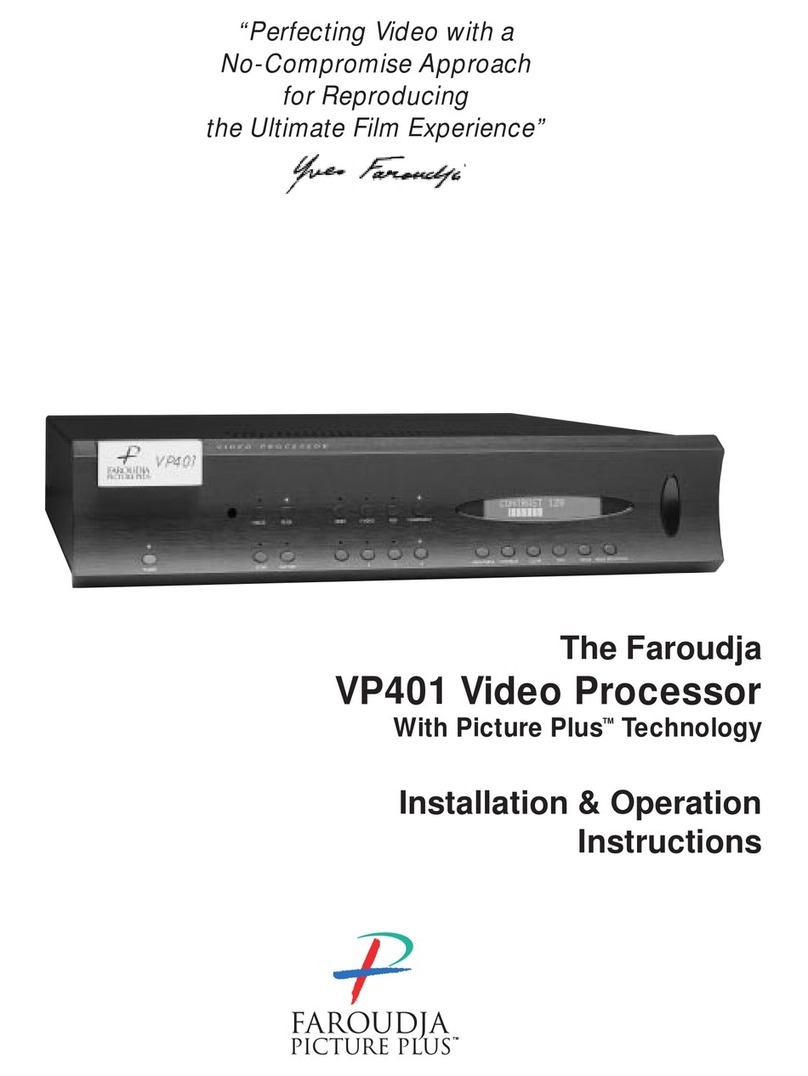Picture Plus™ Technology – The VP251 is called a Line Doubler. However, just increasing the number of lines can
make the image worse. This is where Picture Plus™ technology becomes critical. Picture Plus represents a complex,
multi-stage process that takes advantage of all the patented Faroudja circuitry for color, motion and detail processing.
How these circuits improve the picture are outlined below.
6
STAGE A COLOR PROCESSING: Chroma Bandwidth
Expansion + Adaptive Comb Filter + Cross-Color
Suppression
COLOR BLURRING – The engineers of the 1940’s (and
the 1950’s, before and during the development of color
broadcasting), had no idea that video images would one
day be blown up as large as they are today. They there-
fore designed the color section of the NTSC standard
with severe bandwidth restrictions. This causes colors in
various video images to “blur” and “smear”. These effects
are further aggravated by storage media such as VHS
tapes, that further degrade the chroma or color signal.
e.g. – note how deep reds smear on VHS tape images.
The Faroudja VP251 utilizes proprietary circuitry to
recreate and further correct color details. Technically,
this is accomplished by making use of the sharper black
and white transitions to develop a correction signal
that is then used to sharpen the color transitions. The
result is colors that are restored with sharp details and
video images that retain their original crisp look.
RAINBOW PATTERNS – When you notice the fine
detail of a striped referees shirt rippling with colored
rainbows as the camera pans by, you’ve seen video
cross-color interference.
This annoying artifact is caused by imperfect separation
of the color (chroma) and black and white (luminance)
signals, by the color decoder circuitry. Simple tech-
niques used commonly to separate the two signals can
be effective most of the time but occasionally are fooled
by finer pitch detail areas like the referee’s shirt. The
VP251 has patented cross color suppression that elimi-
nates decoding errors of this type and enables the
reproduction of sharper, cleaner color images.
DOT CRAWL and HANGING DOTS – This phenomenon
is easily seen with large, highly colored, stationary
graphics like titles and credits. Dot crawl is a rapid
upwards movement of colored dots on sharp vertical
transitions. Hanging dots lie underneath all the colored
horizontal transitions. Both of these color aberrations are
artifacts that appear due to an imperfect color decoding
process. The VP251 has an adaptive comb filter that
eliminates both of these distortions. The impact is color
transitions that are clear, sharp and natural.
STAGE B LINE PROCESSING: Film/Video Motion
Tracking
THE VP251 Patented Line Multiplier: eliminates VISIBLE
SCAN LINES – The secret of the VP251’s uncanny abili-
ty to increase the lines of information without adding digi-
tal artifacts is in its unique ability to detect motion and
interpolate correctly. The Faroudja VP251 does this
thanks to its proprietary, patented circuitry. It can detect
the difference between a film image that has been trans-
ferred to video or video image that emanated from a
video camera. After detecting the image type, the VP251
adjusts its algorithm to compensate accordingly.
This is critical because today’s home theaters are pri-
marily used to show films that were transferred to video
whether on tape, laserdisc or off the air (virtually all
prime time programs are film transferred to video). The
VP251 offers sharper, uniquely clean, artifact-free film-
like images without visible scanning lines.
Again, historically speaking, electrical engineers in the
1940’s knew the resolution of a picture tube was depen-
dent on two different mechanisms. Horizontal resolution
is a function of bandwidth (frequency response) of the
TECHNICAL HIGHLIGHTS





























